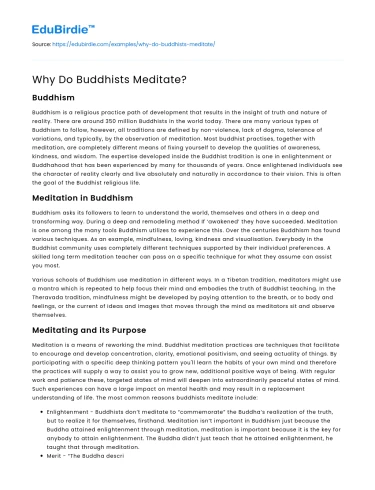Buddhism
Buddhism is a religious practice path of development that results in the insight of truth and nature of reality. There are around 350 million Buddhists in the world today. There are many various types of Buddhism to follow, however, all traditions are defined by non-violence, lack of dogma, tolerance of variations, and typically, by the observation of meditation. Most buddhist practises, together with meditation, are completely different means of fixing yourself to develop the qualities of awareness, kindness, and wisdom. The expertise developed inside the Buddhist tradition is one in enlightenment or Buddhahood that has been experienced by many for thousands of years. Once enlightened individuals see the character of reality clearly and live absolutely and naturally in accordance to their vision. This is often the goal of the Buddhist religious life.
Meditation in Buddhism
Buddhism asks its followers to learn to understand the world, themselves and others in a deep and transforming way. During a deep and remodeling method If ‘awakened’ they have succeeded. Meditation is one among the many tools Buddhism utilizes to experience this. Over the centuries Buddhism has found various techniques. As an example, mindfulness, loving, kindness and visualisation. Everybody in the Buddhist community uses completely different techniques supported by their individual preferences. A skilled long term meditation teacher can pass on a specific technique for what they assume can assist you most.
Save your time!
We can take care of your essay
- Proper editing and formatting
- Free revision, title page, and bibliography
- Flexible prices and money-back guarantee
Various schools of Buddhism use meditation in different ways. In a Tibetan tradition, meditators might use a mantra which is repeated to help focus their mind and embodies the truth of Buddhist teaching. In the Theravada tradition, mindfulness might be developed by paying attention to the breath, or to body and feelings, or the current of ideas and images that moves through the mind as meditators sit and observe themselves.
Meditating and its Purpose
Meditation is a means of reworking the mind. Buddhist meditation practices are techniques that facilitate to encourage and develop concentration, clarity, emotional positivism, and seeing actuality of things. By participating with a specific deep thinking pattern you'll learn the habits of your own mind and therefore the practices will supply a way to assist you to grow new, additional positive ways of being. With regular work and patience these, targeted states of mind will deepen into extraordinarily peaceful states of mind. Such experiences can have a large impact on mental health and may result in a replacement understanding of life. The most common reasons buddhists meditate include:
- Enlightenment - Buddhists don’t meditate to “commemorate” the Buddha’s realization of the truth, but to realize it for themselves, firsthand. Meditation isn’t important in Buddhism just because the Buddha attained enlightenment through meditation, meditation is important because it is the key for anybody to attain enlightenment. The Buddha didn’t just teach that he attained enlightenment, he taught that through meditation.
- Merit - “The Buddha describes the act of “developing a mind of good-will” as creating an abundance of merit that surpasses any other form of merit making. Meaning meditation is not only a fairly easy and simple way to collect merit, it is potentially the best.” Quoted by HuffPost
- The Defilements - Meditation in Buddhism is seen as one of the main ways to eliminate the three mental defilements of greed, hatred and delusion, which in Buddhism are the roots and cause of all suffering.
- The Noble Eightfold Path - Buddha describes The Noble Eightfold Path as the path to the end of suffering. And the way to get there is to meditate and find your way to the end of the path.
Health Lines Guide to Meditation
Take your seat. Sit cross-legged on a meditation cushion or on a straight-backed chair with your feet flat on the floor, without leaning against the back of the chair.
Find your sitting posture. Place your hands palms-down on your thighs and sit in an upright posture with a straight back—relaxed yet dignified. With your eyes open, let your gaze rest comfortably as you look slightly downward about six feet in front of you.
Notice and follow your breath. Place your attention lightly on your out-breath, while remaining aware of your environment. Be with each breath as the air goes out through your mouth and nostrils and dissolves into the space around you. At the end of each out-breath, simply rest until the next in-breath naturally begins. For a more focused meditation, you can follow both the out-breaths and in-breaths.
Note the thoughts and feelings that arise. Whenever you notice that a thought, feeling, or perception has taken your attention away from the breath, just say to yourself, “thinking,” and return to following the breath. No need to judge yourself when this happens; just gently note it and attend to your breath and posture.
End your session. After the allotted time, you can consider your meditation practice period over. But there’s no need to give up any sense of calm, mindfulness, or openness you’ve experienced. See if you can consciously allow these to remain present throughout the rest of your day.
Conclusion
There are many different reasons for meditation that have been proven very beneficial not just for Buddhists but for anyone willing to practise it. To Fully understand meditation and why millions of people practise it, you must take your time to learn and practise it personally. It cannot be fully understood just by learning or reading about it.v






 Stuck on your essay?
Stuck on your essay?

